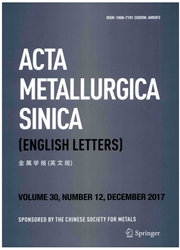

 中文摘要:
中文摘要:
AZ31 Mg 合金的焊接的自动钨惰性的气体(ATIGW ) 用一个六轴的机器人被执行。AZ31 焊接汽车的关节的微观结构和质地的进化被光显微镜学学习,扫描电子显微镜学,精力散的 X 光检查光谱学,和电子反散射衍射。ATIGW 过程在热导致了粗糙的重新使结晶的谷物影响地区(HAZ ) 和在熔化地区(FZ ) 的圆柱的谷物的取向附生的生长。在基础材料(BM ) 和 FZ 之间的质地的实质的变化被检测。{ 0002 } 在 BM 的基础飞机大部分是到卷飞机的表的平行,而在 FZ 的水晶格子的 c 轴使约 25 愠摩倾向了?
 英文摘要:
英文摘要:
The automatic tungsten-inert gas welding(ATIGW) of AZ31 Mg alloys was performed using a six-axis robot. The evolution of the microstructure and texture of the AZ31 auto-welded joints was studied by optical microscopy, scanning electron microscopy, energy-dispersive X-ray spectroscopy, and electron backscatter diffraction. The ATIGW process resulted in coarse recrystallized grains in the heat affected zone(HAZ) and epitaxial growth of columnar grains in the fusion zone(FZ). Substantial changes of texture between the base material(BM) and the FZ were detected. The {0002} basal plane in the BM was largely parallel to the sheet rolling plane, whereas the c-axis of the crystal lattice in the FZ inclined approximately 25° with respect to the welding direction. The maximum pole density increased from 9.45 in the BM to 12.9 in the FZ. The microhardness distribution, tensile properties, and fracture features of the AZ31 auto-welded joints were also investigated.
 同期刊论文项目
同期刊论文项目
 同项目期刊论文
同项目期刊论文
 期刊信息
期刊信息
